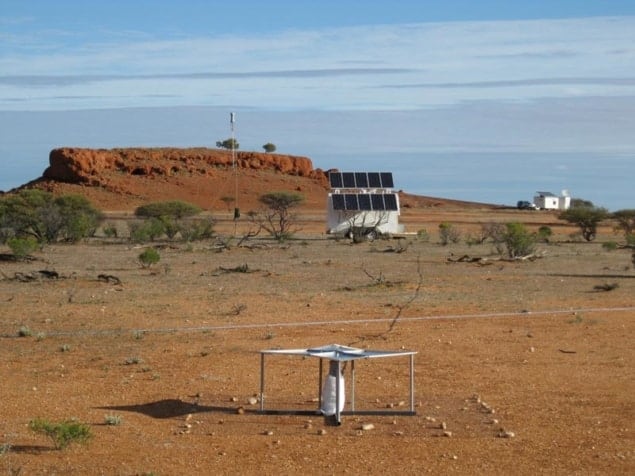
It may look like a picnic table, but this humble piece of kit located in the Australian outback has revealed how the universe emerged from a period called the cosmic dark ages nearly 13 billion years ago. This was the time when the first stars and galaxies began to assert their influence on cosmic evolution, by bombarding the intergalactic medium with ultraviolet light until it had become a warm, ionized plasma.
The EDGES apparatus, a $30,000 radio antenna designed to detect the prominent 21 cm spectral signature of hydrogen, has allowed Judd Bowman of Arizona State University and Alan Rogers of the MIT Haystack Observatory in Massachusetts to place the first direct limit on how fast this cosmological phase transition took place.
“This result marks an observational milestone,” says Rennan Barkana of Tel Aviv University, who was not involved with the work. “Knowing when and how re-ionization happened teaches us a great deal about whatever population of objects existed 300–800 million years after the Big Bang, which could still turn out to be something more exotic than stars such as massive black holes or even decaying dark-matter particles.”
Plunged into darkness
The universe became neutral and transparent about 380,000 years after the Big Bang, when it had cooled sufficiently for protons and electrons to combine into hydrogen atoms. Photons, which before recombination were unable to travel far in the plasma, flew out in all directions and have since been stretched – or redshifted – by the expansion of space to constitute the cosmic microwave background (CMB). There were no luminous objects at that time because matter had yet to clump together under gravity, but 100 million years later the first stars and galaxies began to punch holes in the darkness and their light set about reionizing the intergalactic medium – mostly hydrogen.
Since at these early times (or red shifts) hydrogen’s 21 cm spectral line is stretched to roughly metre wavelengths, EDGES was designed to pick up signals with a frequency between 100-200MHz – in the VHF band. During three months of continuous observation Bowman and Rogers looked for the highly red-shifted 21 cm signal, which is expected to be extremely weak because it comes from transitions between the lowest energy states of hydrogen in which the spin of the electron and proton are either aligned or anti-aligned.
Having painstakingly subtracted the much stronger low-frequency signals coming from the magnetized plasma in the Milky Way and nearby galaxies, not to mention interference from terrestrial TV and radio transmissions, the team concluded that reionization did not end abruptly but took place over a red shift larger than 0.06. That translates to a period of at least 5 million years.
“This was expected in all theoretical models that forecast reionization by the first stars, but is now an observational statement,” says theorist Avi Loeb of Harvard University. “Most of the 21 cm community is involved in the construction of interferometers (whose cost is larger by two orders of magnitude) that image the sky as well, so it is gratifying to see that an innovative experiment succeeded in getting the first constraints.”
21 cm cosmology
Until now there have been two types of observational data on reionization: anisotropies in the cosmic microwave background as measured by WMAP and observations of the light from distant quasars. These data indicate that the universe was already fully ionized by redshift 6.5 (corresponding to about 1billion years after the big bang), but Barkana says that studying hydrogen’s 21 cm emission is very promising for going back to the period 200 million years after the Big Bang. “21 cm cosmology is opening up a new observational cosmic window,” said Barkana. “At least one, perhaps two more cosmic transitions should have left spectral fossils.”
“So far EDGES has only set limits and not made a detection,” says Rogers. “We hope that we might detect the early hydrogen and put some real numbers on the red-shift, but it remains to be seen how far EDGES can go.”
The research is published in Nature 468 796.



